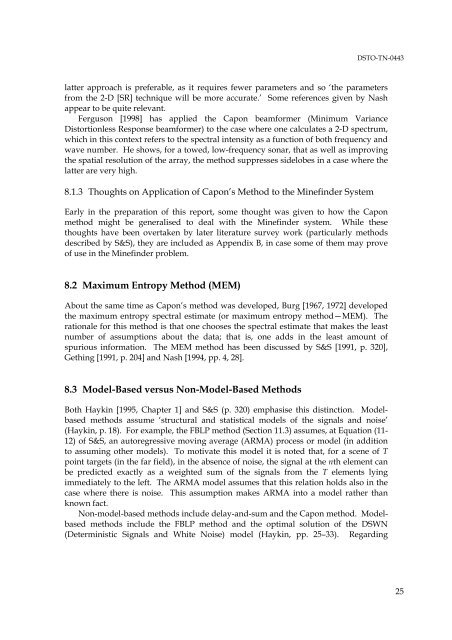Suitability of Correlation Arrays and Superresolution for Minehunting ...
Suitability of Correlation Arrays and Superresolution for Minehunting ...
Suitability of Correlation Arrays and Superresolution for Minehunting ...
Create successful ePaper yourself
Turn your PDF publications into a flip-book with our unique Google optimized e-Paper software.
DSTO-TN-0443<br />
latter approach is preferable, as it requires fewer parameters <strong>and</strong> so ‘the parameters<br />
from the 2-D [SR] technique will be more accurate.’ Some references given by Nash<br />
appear to be quite relevant.<br />
Ferguson [1998] has applied the Capon beam<strong>for</strong>mer (Minimum Variance<br />
Distortionless Response beam<strong>for</strong>mer) to the case where one calculates a 2-D spectrum,<br />
which in this context refers to the spectral intensity as a function <strong>of</strong> both frequency <strong>and</strong><br />
wave number. He shows, <strong>for</strong> a towed, low-frequency sonar, that as well as improving<br />
the spatial resolution <strong>of</strong> the array, the method suppresses sidelobes in a case where the<br />
latter are very high.<br />
8.1.3 Thoughts on Application <strong>of</strong> Capon’s Method to the Minefinder System<br />
Early in the preparation <strong>of</strong> this report, some thought was given to how the Capon<br />
method might be generalised to deal with the Minefinder system. While these<br />
thoughts have been overtaken by later literature survey work (particularly methods<br />
described by S&S), they are included as Appendix B, in case some <strong>of</strong> them may prove<br />
<strong>of</strong> use in the Minefinder problem.<br />
8.2 Maximum Entropy Method (MEM)<br />
About the same time as Capon’s method was developed, Burg [1967, 1972] developed<br />
the maximum entropy spectral estimate (or maximum entropy method—MEM). The<br />
rationale <strong>for</strong> this method is that one chooses the spectral estimate that makes the least<br />
number <strong>of</strong> assumptions about the data; that is, one adds in the least amount <strong>of</strong><br />
spurious in<strong>for</strong>mation. The MEM method has been discussed by S&S [1991, p. 320],<br />
Gething [1991, p. 204] <strong>and</strong> Nash [1994, pp. 4, 28].<br />
8.3 Model-Based versus Non-Model-Based Methods<br />
Both Haykin [1995, Chapter 1] <strong>and</strong> S&S (p. 320) emphasise this distinction. Modelbased<br />
methods assume ‘structural <strong>and</strong> statistical models <strong>of</strong> the signals <strong>and</strong> noise’<br />
(Haykin, p. 18). For example, the FBLP method (Section 11.3) assumes, at Equation (11-<br />
12) <strong>of</strong> S&S, an autoregressive moving average (ARMA) process or model (in addition<br />
to assuming other models). To motivate this model it is noted that, <strong>for</strong> a scene <strong>of</strong> T<br />
point targets (in the far field), in the absence <strong>of</strong> noise, the signal at the nth element can<br />
be predicted exactly as a weighted sum <strong>of</strong> the signals from the T elements lying<br />
immediately to the left. The ARMA model assumes that this relation holds also in the<br />
case where there is noise. This assumption makes ARMA into a model rather than<br />
known fact.<br />
Non-model-based methods include delay-<strong>and</strong>-sum <strong>and</strong> the Capon method. Modelbased<br />
methods include the FBLP method <strong>and</strong> the optimal solution <strong>of</strong> the DSWN<br />
(Deterministic Signals <strong>and</strong> White Noise) model (Haykin, pp. 25–33). Regarding<br />
25

















